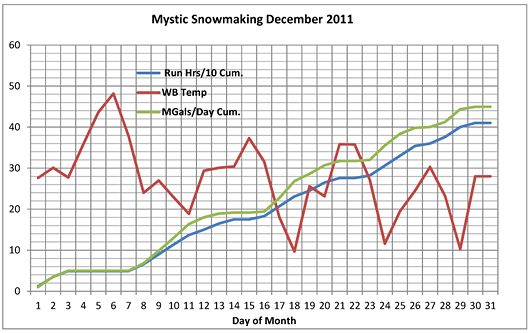December 2011 was a very challenging year for snowmaking and perhaps one of the warmest in recent history. The average temperature for the month at Mystic Mountain (an actual resort in Vermont) was 27.5º F, with 410 hours of operation and an output of 44.9 Mgals. of water. The average water flow for this month was 1,827 gpm. This information and other data were documented in the SAM article, “Get Ready” of the SAM November 2012 issue (also at saminfo.com/article/get-ready).
After a difficult start for 2012, the question arises: How did November and December 2012 compare with 2011? The results are a bit surprising.
November 2012 turned into a very strong snowmaking month. Many areas in New England outputted 40 to 50 percent of their yearly water volume. Using real time data from Mystic Mountain, the average temperature was 27.2º F, with 249 hours of operation and an output of 32.8 Mgals. of water. The average water flow for this month was 2,200 gpm. Water availability was a non-issue. (Comparison data for November 2011: average temperature of 35.4 F, 36 operating hours, 2.57 Mgals of output and an average flow of 1,188 gpm).

However, for the month of December 2012, the average temperature was 24.8 F, with 286 hours of operation and an output of 32.8 Mgals. of water. Water availability hampered operating hours and output due to the dry November. The average water flow for this month was 1,911 gpm.

In essence, for this ski area, December 2011, November 2012, and December 2012 were very close in average temperature. However, averages can be very deceptive, and do not always represent an accurate picture of the operating reality. This can be seen in the charts here.

For example, note the compressed temperature band for December 2012 vs. 2011. This information shows that the actual operating temperatures and potential run hours for snowmaking operations in December 2012 were inferior to December 2011. (Please note that this area implemented many of the recommendations in “Get Ready,” or else its production in December 2012 would have been even lower.) November 2012 truly saved the bacon, at least for this location.
In conclusion, December 2012 was a weaker snowmaking month than December 2011 due to the lack of low-teens temperatures and a prolonged stretch of warm temperatures early in the month. November 2012 was a bonus month for snowmaking operations and helped lift Christmas trail counts in northern New England way above last year’s numbers. Fall 2012 showed the wisdom of making snow whenever temperatures are favorable—one never knows what the future holds.




 by Yaroslav Stanchak, Mountain View Techno
by Yaroslav Stanchak, Mountain View Techno